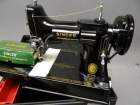If you are a quilter, chances are you are all ready to sing the praises of this beautifully black boxed sewing machine by Singer. Item 143 in our current auction is a famous “Featherweight.” The Singer Featherweight portable sewing machine is a model made by Singer between 1933 and 1964. They even have a fan club on Facebook
.
The machine weighs about 11 pounds and is an ideal for quilters and other heirloom sewers to take to classes or "on location." Very quiet and sturdily made with all-metal parts (mostly aluminum), the Featherweight sews straight stitches beautifully
.
My sewing expert, teacher and dear friend Kathianne has one and uses hers all this time. She even has the card table that was especially made for the Featherweight. She has the hemmer, the button-holer, ruffler, tucker and lots of attachments. You can find all of the extras at her favorite website www.April1930s.com.
The Featherweight came in a standard black model made in the U.S. Ours was made after the war and has a simple, striated pattern of vertical stripes. It is decorated with gold decals and the Singer name, but no where does it say "Featherweight" on it
Who gave them that nickname seems to be lost to time. What was is not lost is the love of the machines by those who have and use them.
Kathianne tells me finding the approximate date of manufacture of a Featherweight is easy. Turn it over and see if the serial number is still there. The number, which is on the bottom of the machine, will be preceded by a two-letter code, beginning with A (for U.S.-made model 221 machines). The letters not the numbers tell the story. Here is the chart to decode your machine.
• AB 1926
• AC 1928
• AD 1934
• AE 1936
• AF 1938
• AG 1941
• AH 1948
• AI 1948
• AJ 1950
• AK 1951
• AL 1955
• AM 1956
White Featherweights, distributed in the U.S., were made between 1968 and 1970. These were the last gasp of the Featherweight as a new machine. You can call Singer with the serial number and find out. 1(800)474-6437 or go to www.Singerco.com for free downloadable sewing projects. Now, Featherweights are being refurbished and painted in every color under the rainbow.
Featherweight Sewing Machines and their Fans are Fantastic!
Happy Bidding,
Liz
Your description of featherweights is accurate and informative. These are great little machines and highly desirable collectables. They sew a great stitch and are dependable. We purchased our first featherweight last year when my wife started quilting and she loves them.
ReplyDeleteThanks Ed! I am posting the shipping instructions you provided so others can benefit from your wise advice.
ReplyDelete-Remove the spool holder that is on the top of the sewing machine toward the right and replace the little screw that holds its plate in place back into the machine body. This will stop the metal rod from being damaged or from damaging the case lid.
-Place something between the flip up bed and the faceplate screw. Cardboard is fine.
-Push the bobbin winder against the belt so that it cannot damage the lid or be snapped into two pieces. It is cast iron and therefore brittle.
-Screw down the presser foot tension thumbscrew as far as it will go. It is chrome and on top of the machine on the left. This will help stop the screw from possibly cracking the case lid.
-Wrap the accessories (particularly the metal ones), the foot control and plug. Wrap something around the machine to help prevent damage. Bubble wrap is great.
-Empty the oil can as much as possible and then put it in a sealed zip lock bag with a paper towel wrapped around it. A second zip lock bag would be appreciated. A little oil goes a long way in ruining a case.
-Put the instruction manual into a zip lock bag.
-Make sure that the machine and accessories are not able to move around in the case. This almost totally eliminates any damage. Do not use large airbags since they pop in transit. Bubble wrap works well; newspapers are better than nothing. ----Make sure that there is no movement inside the case is critical. Movement inside the case usually causes damage